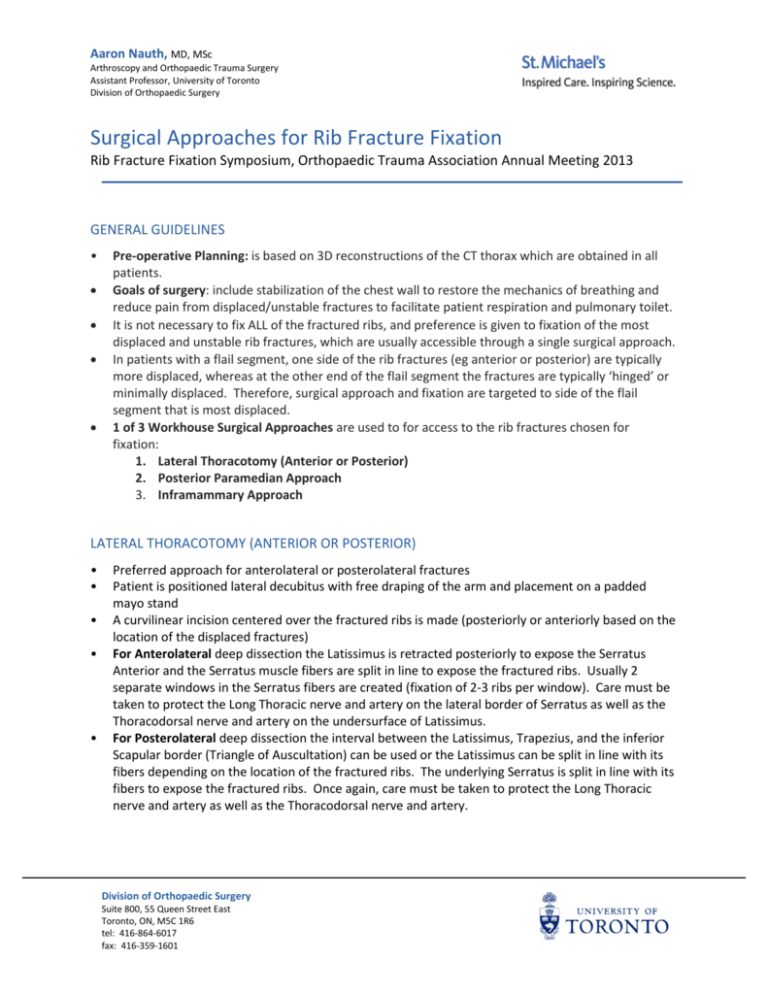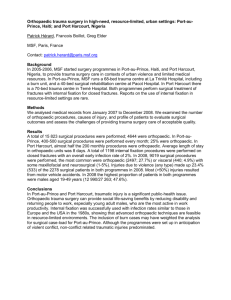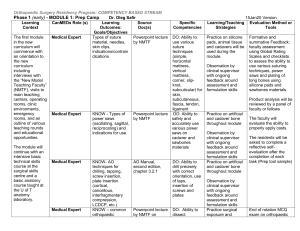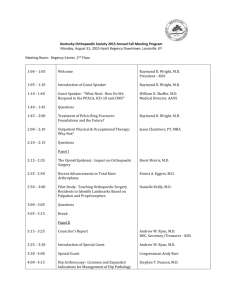Surgical Approaches for Rib Fracture Fixation
advertisement

Aaron Nauth, MD, MSc Arthroscopy and Orthopaedic Trauma Surgery Assistant Professor, University of Toronto Division of Orthopaedic Surgery Surgical Approaches for Rib Fracture Fixation Rib Fracture Fixation Symposium, Orthopaedic Trauma Association Annual Meeting 2013 GENERAL GUIDELINES • • • • • Pre-operative Planning: is based on 3D reconstructions of the CT thorax which are obtained in all patients. Goals of surgery: include stabilization of the chest wall to restore the mechanics of breathing and reduce pain from displaced/unstable fractures to facilitate patient respiration and pulmonary toilet. It is not necessary to fix ALL of the fractured ribs, and preference is given to fixation of the most displaced and unstable rib fractures, which are usually accessible through a single surgical approach. In patients with a flail segment, one side of the rib fractures (eg anterior or posterior) are typically more displaced, whereas at the other end of the flail segment the fractures are typically ‘hinged’ or minimally displaced. Therefore, surgical approach and fixation are targeted to side of the flail segment that is most displaced. 1 of 3 Workhouse Surgical Approaches are used to for access to the rib fractures chosen for fixation: 1. Lateral Thoracotomy (Anterior or Posterior) 2. Posterior Paramedian Approach 3. Inframammary Approach LATERAL THORACOTOMY (ANTERIOR OR POSTERIOR) • • • • • Preferred approach for anterolateral or posterolateral fractures Patient is positioned lateral decubitus with free draping of the arm and placement on a padded mayo stand A curvilinear incision centered over the fractured ribs is made (posteriorly or anteriorly based on the location of the displaced fractures) For Anterolateral deep dissection the Latissimus is retracted posteriorly to expose the Serratus Anterior and the Serratus muscle fibers are split in line to expose the fractured ribs. Usually 2 separate windows in the Serratus fibers are created (fixation of 2-3 ribs per window). Care must be taken to protect the Long Thoracic nerve and artery on the lateral border of Serratus as well as the Thoracodorsal nerve and artery on the undersurface of Latissimus. For Posterolateral deep dissection the interval between the Latissimus, Trapezius, and the inferior Scapular border (Triangle of Auscultation) can be used or the Latissimus can be split in line with its fibers depending on the location of the fractured ribs. The underlying Serratus is split in line with its fibers to expose the fractured ribs. Once again, care must be taken to protect the Long Thoracic nerve and artery as well as the Thoracodorsal nerve and artery. Division of Orthopaedic Surgery Suite 800, 55 Queen Street East Toronto, ON, M5C 1R6 tel: 416-864-6017 fax: 416-359-1601 Aaron Nauth, MD, MSc Arthroscopy and Orthopaedic Trauma Surgery Assistant Professor, University of Toronto Division of Orthopaedic Surgery Surgical Approaches for Rib Fracture Fixation Rib Fracture Fixation Symposium, Orthopaedic Trauma Association Annual Meeting 2013 POSTERIOR PARAMEDIAN APPROACH • • • • Preferred approach for posterior fractures Patient is positioned lateral decubitus with free draping of the arm and placement on a padded mayo stand A vertical linear incision centered over the fractured ribs is made parallel to the Spinous Processes Deep dissection is carried out in the interval between the Latissimus, Trapezius, and the inferior Scapular border (Triangle of Auscultation) exposing the underlying Erector Spinae muscle. The Erector Spinae is then elevated towards the midline to expose the posteriorly fractured ribs. INFRAMAMMARY APPROACH • • • • Preferred approach for anterior fractures and costochondral dislocations Patient is positioned supine with the arm extended at 90 degrees to the thorax, free draping of the arm is not required A horizontal incision inferior to Pectoralis Major is made along the Inframammary crease Deep dissection is carried out underneath the Pectoralis Major exposing the Serratus Anterior fibers and the costochondral junctions if necessary. Serratus fibers are split in line to expose the underlying ribs. Caudally, splitting of the external oblique fibers may be necessary. REFERENCES1-3 1. 2. 3. Althausen PL, Shannon S, Watts C, et al. Early surgical stabilization of flail chest with locked plate fixation. J Orthop Trauma. Nov 2011;25(11):641-647. Hasenboehler EA, Bernard AC, Bottiggi AJ, et al. Treatment of traumatic flail chest with muscular sparing open reduction and internal fixation: description of a surgical technique. J Trauma. Aug 2011;71(2):494-501. Taylor BC, French BG, Fowler TT. Surgical approaches for rib fracture fixation. J Orthop Trauma. Jul 2013;27(7):e168-173. Division of Orthopaedic Surgery Suite 800, 55 Queen Street East Toronto, ON, M5C 1R6 tel: 416-864-6017 fax: 416-359-1601








